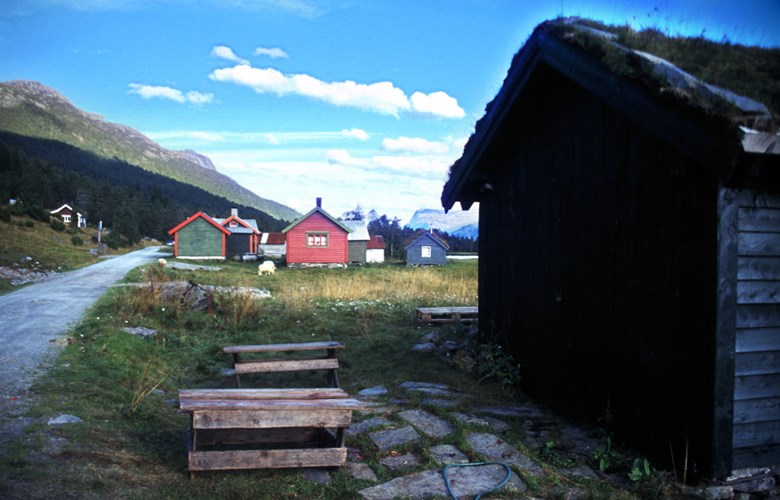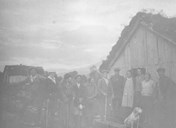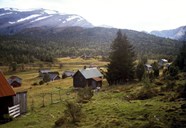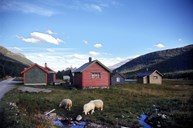30 buildings
From days of old there were 30 buildings at Myklebustsætra, 10 cottages, 10 cowsheds and 10 barns. We do not know their exact age, but the cottages had an open fireplace and a smoke vent in the ceiling, which was rare after 1850. The mountain farm was divided among as many as 12 holders at Myklebust.
Mountain farming was a key element in the exploitation of the natural resources.
For a long while mountain farming was an important element in the use of the local natural resources, both in the county of Sogn og Fjordane as elsewhere in the country. This farming system is considered to be just as old as the farm operation itself, but a large number of the mountain farms we know today date from 18th century. When the number of mountain farms increased, it may be an indication of the population growth and the following expansion of the cultural landscape. We do not know the maximum number of mountain farms, but in the first survey of mountain farms in 1907, more than 10 000 mountain farms were registered in this county alone.
Every mountain farm played an important part in the operation of the home farm. Before the introduction of the mechanized culture started in earnest, most of the production took place in the summer months. In the course of a few hectic summer weeks, a large part of the production of the livestock was taken out, whereas the winter was a passive season where the main purpose was to keep their livestock alive until the following summer. In this context, the mountain farms played a highly important role in the production of cheese and butter, but also to raise well-fed fatstock. In a typical "mountain farm municipality" such as old Lavik, we can estimate that about one third of the amount of the milk production came from the mountain farms.
Summer farm and milk farm
In this district there is an important distinction between two farming systems, summer farm and milk farm. The milk farm - as the name indicates - was only used for milking and the milk was carried home every day. Even if this milk farm was located closer to the home farm, people would still have to carry the milk for several kilometres, often in a steep and rough terrain.
Myklebustsætra belongs to the second category, the summer farm. This was a more organized farming system than with the milk farm. Normally this type of farm was located much further away from the home farm. The Myklebust people, for example, had to walk five kilometres with an altitude difference of about 250 metres. The summer farms were also characterized by having a regular farmyard layout with a shed for the cows and a separate cottage for people.
Girls and women ran the summer farms on their own
The running of the summer farms was taken care of by the milkmaids. They were usually young girls or wives from Myklebust. It became gradually more common to hire milkmaids from elsewhere. In addition to the milkmaids, there were sometimes young shepherd boys who looked after the cattle and warned if there were beasts of prey in the neighbourhood. Most of the work, however, was taken care of by the milkmaids, who had a busy time what with milking and looking after the animals. Milking, churning and cheese-making were all time-consuming chores. Butter was a highly important product that one could get a good price for, and as the mountain butter was considered to be of a particularly good quality, they would get a better price compared to farm-made butter. Consequently, this production was of special importance at a time when the cash income from the ordinary farm operation was insignificant.
Not only hard work
Even if mountain farming could mean hard work, it could also be a rich period, socially speaking. The place was teeming with visitors and activities and the milkmaids and shepherd boys were gathered there throughout the summer weeks. In addition, the distance was short across to Vikasætra on the other side of the lake of Sætravatnet. With so many girls gathered at one place it was no wonder that some boys also came to visit on a Saturday evening, or that the whole family came up on a fine Saturday afternoon from their home farm at Ålfoten. At the summer farm they then gathered for some sour-cream porridge, and sometimes fiddle-playing and dancing.
Wood nymphs and beasts of prey
Wood nymphs were also said to have been frequent guests at the summer farms. With good fishing and ample game the valley of Myklebustdalen could be an excellent place for such creatures. It has been told that one could come across the wood nymphs themselves and their livestock around the summer farm. The "little people" could easily make trouble for the summer farming if they felt that they had not been treated with respect. On the other hand, they could also be helpful if the relationship between wood nymphs and people was good. In this way they were either credited or blamed if something good or bad happened at the summer farm.
One story deals with an intense love affair between people at the summer farm and the "little people". A case in point is the story about a man from Myklebust called "Samså-Anders" who in his younger days felt so hopelessly in love with an attractive wood nymph that he almost lost his senses. These girls must have been extraordinarily beautiful. According to another story from some other place at old Davik: "When I look into her glittering dark eyes, what is still left of my senses disappears."
However, if the relationship between the people at the summer farms and the "little people" at times could be good, the relationship to bears and other beasts of prey was on the whole quite bad. In the area around Myklebustsætra people could come across both bear and wolf watching with hungry eyes the domestic animals grazing on the pastures. The last bear at Ålfoten was shot at Svorsegga to the northeast of Myklebustsætra in 1888. Since that year, very few observations have been made both of beasts of prey and the "little people".
Winding down the operation
In the county of Sogn og Fjordane as elsewhere in the country the summer farm system had mostly come to an end in the late 20th century. The establishment of dairies made it no longer profitable to produce butter in the mountains. At the same time, calving and milk production could now be done all year round. Cultivation of new fields and better fertilizing of pastures and fields led to less dependence of the mountain pastures.
When it was possible to keep on with summer farming at Myklebustsætra also into the 21st century, this was primarily due to its location near the road between Svelgen and Ålfoten. Thus the milk could be delivered just as easily from the summer farm as from their home farm at Myklebust. The four holdings that still use the summer farms no longer make cheese or butter, but deliver only milk. In 1994, the summer farm was upgraded when the owners together invested in a diesel generator to operate the milking machines and the tanking facility.
Even if there is still activity at Myklebustsætra, it is quieter now, especially in the summer months. During the deer-hunting season, however, there may still be some activity at the summer farm. One of the barns has been rebuilt into a slaughtering facility, which makes the summer farm an important place for many keen hunters.






